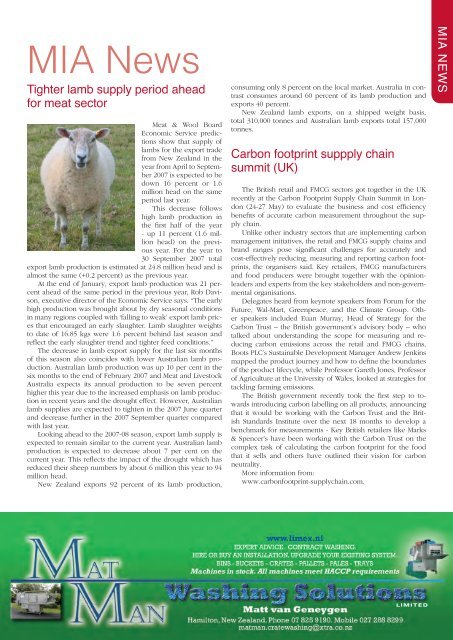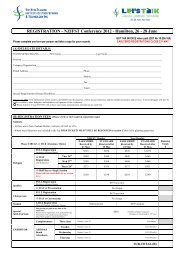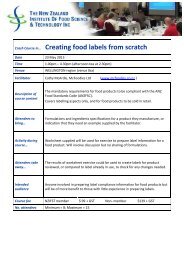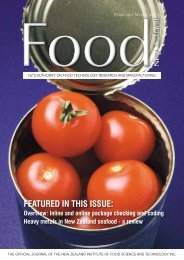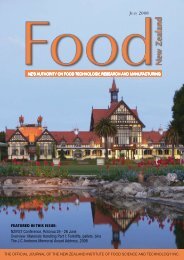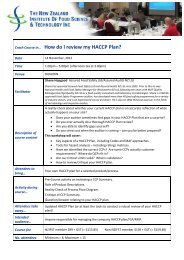FEATURED IN THIS ISSUE - NZIFST - The New Zealand Institute of ...
FEATURED IN THIS ISSUE - NZIFST - The New Zealand Institute of ...
FEATURED IN THIS ISSUE - NZIFST - The New Zealand Institute of ...
Create successful ePaper yourself
Turn your PDF publications into a flip-book with our unique Google optimized e-Paper software.
MIA <strong>New</strong>sTighter lamb supply period aheadfor meat sectorMeat & Wool BoardEconomic Service predictionsshow that supply <strong>of</strong>lambs for the export tradefrom <strong>New</strong> <strong>Zealand</strong> in theyear from April to September2007 is expected to bedown 16 percent or 1.6million head on the sameperiod last year.This decrease followshigh lamb production inthe first half <strong>of</strong> the year- up 11 percent (1.6 millionhead) on the previousyear. For the year to30 September 2007 totalexport lamb production is estimated at 24.8 million head and isalmost the same (+0.2 percent) as the previous year.At the end <strong>of</strong> January, export lamb production was 21 percentahead <strong>of</strong> the same period in the previous year, Rob Davison,executive director <strong>of</strong> the Economic Service says. “<strong>The</strong> earlyhigh production was brought about by dry seasonal conditionsin many regions coupled with ‘falling to weak’ export lamb pricesthat encouraged an early slaughter. Lamb slaughter weightsto date <strong>of</strong> 16.85 kgs were 1.6 percent behind last season andreflect the early slaughter trend and tighter feed conditions.”<strong>The</strong> decrease in lamb export supply for the last six months<strong>of</strong> this season also coincides with lower Australian lamb production.Australian lamb production was up 10 per cent in thesix months to the end <strong>of</strong> February 2007 and Meat and LivestockAustralia expects its annual production to be seven percenthigher this year due to the increased emphasis on lamb productionin recent years and the drought effect. However, Australianlamb supplies are expected to tighten in the 2007 June quarterand decrease further in the 2007 September quarter comparedwith last year.Looking ahead to the 2007-08 season, export lamb supply isexpected to remain similar to the current year. Australian lambproduction is expected to decrease about 7 per cent on thecurrent year. This reflects the impact <strong>of</strong> the drought which hasreduced their sheep numbers by about 6 million this year to 94million head.<strong>New</strong> <strong>Zealand</strong> exports 92 percent <strong>of</strong> its lamb production,consuming only 8 percent on the local market. Australia in contrastconsumes around 60 percent <strong>of</strong> its lamb production andexports 40 percent.<strong>New</strong> <strong>Zealand</strong> lamb exports, on a shipped weight basis,total 310,000 tonnes and Australian lamb exports total 157,000tonnes.Carbon footprint suppply chainsummit (UK)<strong>The</strong> British retail and FMCG sectors got together in the UKrecently at the Carbon Footprint Supply Chain Summit in London(24-27 May) to evaluate the business and cost efficiencybenefits <strong>of</strong> accurate carbon measurement throughout the supplychain.Unlike other industry sectors that are implementing carbonmanagement initiatives, the retail and FMCG supply chains andbrand ranges pose significant challenges for accurately andcost-effectively reducing, measuring and reporting carbon footprints,the organisers said. Key retailers, FMCG manufacturersand food producers were brought together with the opinionleadersand experts from the key stakeholders and non-governmentalorganisations.Delegates heard from keynote speakers from Forum for theFuture, Wal-Mart, Greenpeace, and the Climate Group. Otherspeakers included Euan Murray, Head <strong>of</strong> Strategy for theCarbon Trust – the British government’s advisory body – whotalked about understanding the scope for measuring and reducingcarbon emissions across the retail and FMCG chains,Boots PLC’s Sustainable Development Manager Andrew Jenkinsmapped the product journey and how to define the boundaries<strong>of</strong> the product lifecycle, while Pr<strong>of</strong>essor Gareth Jones, Pr<strong>of</strong>essor<strong>of</strong> Agriculture at the University <strong>of</strong> Wales, looked at strategies fortackling farming emissions.<strong>The</strong> British government recently took the first step to towardsintroducing carbon labelling on all products, announcingthat it would be working with the Carbon Trust and the BritishStandards <strong>Institute</strong> over the next 18 months to develop abenchmark for measurements - Key British retailers like Marks& Spencer’s have been working with the Carbon Trust on thecomplex task <strong>of</strong> calculating the carbon footprint for the foodthat it sells and others have outlined their vision for carbonneutrality.More information from:www.carbonfootprint-supplychain.com.MIA NEWS July 200739


